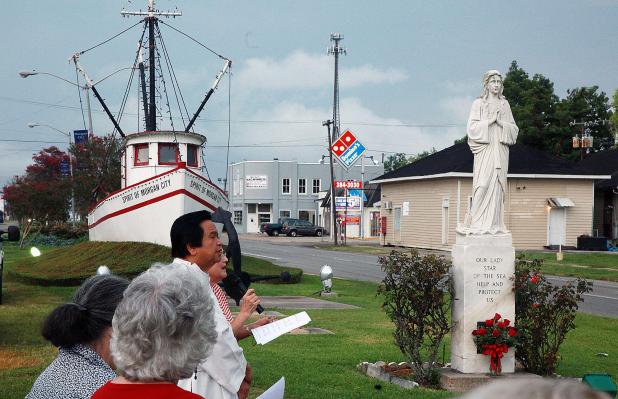
The Rev. Freddie Decal, above, leads the Confraternity of Our Lady of the Star of the Sea in a prayer for protection from hurricanes Sunday night at the statue in the Brashear Avenue median in Morgan City.
From the Editor: Prayers and predictions
“You pray for the hungry,” Pope Francis tells us. “Then you feed them. That is how prayer works.”
Praying for protection against hurricanes works like that, too.
You pray to be spared. Then you buy lots of AA batteries. That’s how hurricane prayers work.
Sunday night, the Confraternity of Our Lady Star of the Sea celebrated the 43rd anniversary of the day the Our Lady Star of the Sea statue was placed in the median of Brashear Avenue in Morgan City in front of the Spirit of Morgan City shrimp boat. Members pray at the statue each year for protection from hurricanes.
The good people at the statue Sunday night appear to be doing some good. It’s been 26 years since Hurricane Andrew, probably the worst storm in recent memory.
The recent predictions for tropical weather are more favorable than the ones that came out in the spring.
Colorado State University’s weather people, the protégés of the late meteorologist William Gray, now expect a below-average season with four hurricanes. The earlier prediction was for seven.
Atlantic Ocean temperatures have been lower than usual. Hurricanes feed and strengthen on ocean heat, so less heat means fewer and weaker storms.
We may also see the return of El Niño by late summer or early fall.
El Niño, the periodic pattern of warmer than average ocean temperatures in the south Pacific, causes all kinds of weather headaches across the country, from floods to droughts. But El Niño also tends to send winds eastward over the subtropical and tropical zones of our hemisphere, shearing the tops off tropical weather systems before they grow to dangerous proportions.
That’s no reason to be complacent. Almost by definition, the storms that get through during El Niño years are going to be bruisers.
One was Audrey in 1957, a storm that suddenly intensified one June night and came ashore in Cameron Parish to kill at least 500 people.
Andrew struck in 1992, also a year marked by an El Niño pattern.
I was raised in Missouri and came to Louisiana in 1990, so Andrew was my first hurricane. Memories center on aggravation: three days without power at the mobile home I rented in St. Martin Parish; endless traffic jams; waiting in line for gas, food and everything else; and watching Andrew move into the Gulf to zero in on south Louisiana after devastating the southern tip of Florida.
Working for the Lafayette paper, photographer Peter Piazza and I took off the morning after Andrew hit and drove to Abbeville, where the biggest troubles were downed tree limbs. After so many years without a big storm, even a small one can fling dead limbs around.
Some of them will strike roofs and powerlines. Coulees tend to get clogged, too, adding to any flood danger.
We cut east to U.S. 90, and then toward St. Mary. We saw a group of three or four mobile homes, one of which had its frame picked clean by the wind. A few yards away was a trailer that seemed untouched. To this Midwestern boy, that looked like damage from a small tornado.
In Franklin, the wind knocked down several mature cedar trees. The sight of those beautiful trees on the ground was awful. But they smelled great.
Pete and I ran into David Naquin, then with the sheriff's office. He told us how the wind had whipped through the driveway that runs beneath the courthouse. We heard later that an anemometer, a device for measuring wind speed, hit 160 mph before blowing apart.
For the first time, I got to Morgan City, where I would go to work 23 years later. The standout memory is seeing brightly colored birds flying around. We weren’t sure whether a pet store got wasted or Andrew had blown tropical birds our way from the Caribbean.
We drove back up La. 182 to Jeanerette, near which we found a young woman on a ladder, covering her roof with plastic. Her home was badly damaged. The rain had barely stopped.
In Jeanerette, we drove through the downtown area memorable for its old red-brick buildings. We saw one of those brick walls that had been nearly knocked down by the wind. That brought home the magnitude of what Andrew had done to our region.
Within a few days, we all had our power and AC back. We’d cooked or thrown out the food that had thawed. We’d bundled up the limbs and other debris. We’d negotiated with our insurance companies.
And many of us, even those who had it pretty bad, said our own kind of hurricane prayer:
Thank God it wasn’t worse.
Bill Decker is managing editor of The Daily Review.
